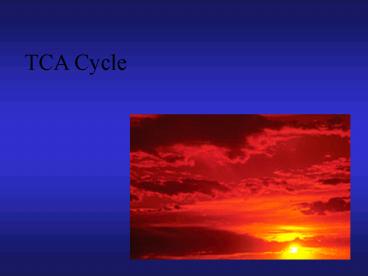TCA Cycle - PowerPoint PPT Presentation
1 / 32
Title:
TCA Cycle
Description:
Step 6: Oxidation of Succinate to Fumarate. 1 mole FADH2 produced ... Step 7: Hydration of Fumarate to Malate. Stereospecific enzyme: D-malate is not a substrate ... – PowerPoint PPT presentation
Number of Views:167
Avg rating:3.0/5.0
Title: TCA Cycle
1
TCA Cycle
2
The 3-stage engine
glucose
Stage 2
3
Topics TCA
- TCA cycle has a central role in energy metabolism
- Is fed by breakdown of carbohydrate lipid
amino acids - Carbon is released as CO2
- Individual reactions in the cycle
- Energy is generated as NADH, FADH2 and GTP
- Intermediates of TCA are used for biosynthesis of
amino acids and other metabolites
4
TCA cycle (with glycolysis) is the central
pathway of energy metabolism
5
Different names, same process
- TCA cycle
- tricarboxylate acid cycle
- citric acid cycle
- Krebs cycle (for Sir Hans)
6
(later)
Catabolism of amino acids, fats, and
carbohydrates in the three stages of cellular
respiration
7
Carbon is released as CO2
8
What is being accomplished chemically in TCA?
Cycle to burn C2 produce reducing equivalents
(energy) and CO2
9
The overall cycle All 8 reactions
What are the net products? How do they transfer
metabolic energy?
10
Individual reactions in the cycle
11
Step 1 Formation of Citrate
12
Citrate Synthase undergoes a dramatic
conformational change upon binding of the first
substrate, oxaloacetate
Induced Fit
13
Steps 2a 2b Formation of Isocitrate via
cis-Aconitate
- dehydration of C3 to double bond
- rehydration at C2 (10 isocitrate) and C3 (90
citrate) - forward rxn driven by isocitrate utilization
14
Iron-sulfur reaction center in aconitase
15
Step 3 Oxidation of Isocitrate to
a-Ketoglutarate and CO2
1st carbon lost as CO2 1st production of NADH
16
NADaccepts electrons in the form of hydride
(H-) transfer required for the oxidation of an
alcohol (isocitrate) to a ketone (a-KG) on
isocitrate deH-ase
and again at a-KG deH-ase and malate deH-ase
17
Step 4 Oxidation of a-Ketoglutarate to
Succinyl-CoA and CO2
- Similar enzyme, identical mechanism to PyrDH
- E1, E2, E3
- Coenzymes TPP, lipoic acid, FAD, NAD and CoA
2nd NADH made 2nd CO2 lost
18
Step 5 Conversion of Succinyl-CoA to Succinate
1 mole GTP (ATP) produced
19
Step 6 Oxidation of Succinate to Fumarate
1 mole FADH2 produced
20
FADcoenzyme in oxidizing succinate to fumarate
R
(H and H-)
on succinate deH-ase
21
Step 7 Hydration of Fumarate to Malate
Stereospecific enzyme D-malate is not a substrate
22
Step 8 Oxidation of Malate to Oxaloacetate
Reaction is driven by oxaloacetate utilization
(citrate synthase)
3rd NADH produced
23
Regulation of metabolite flow from pyruvate
through the TCA cycle
24
Energy is generated as NADH, FADH2 and GTP
25
Products of one turn of the citric acid cycle
26
12 ATP molecules produced from oxidation of 1
Acetyl CoA
27
Role of the TCA cycle in anabolic (biosynthetic)
pathways
(NOT in humans)
28
Example of an amino acid produced from a TCA
intermediate
Reaction is a transamination
29
TCA intermediates used for biosynthesis are
replenished by side reactions
30
Anaplerotic Reactions, such as that catalyzed by
Pyruvate Carboxylase, keep the TCA cylcle
replenished with intermediates used as
biosynthetic precursors. Acetyl CoA stimulates
Pyruvate Carboxylase allosterically.
31
- Role of Biotin in Pyruvate Carboxylase.
- Carrier of CO2 activated by ATP,
- Covalently linked to a lysine on enzyme,
- Biotin, required in the diet, is bound by avidin,
a protein in raw egg whites.
32
- You should know
- Where the TCA cycle occurs (mitochondria)
- The reactions and intermediates of TCA cycle
- How carbohydrate carbons are converted to CO2
(through AcCoA) - How are NADH, FADH2 and GTP produced? How much?
- The regulated steps in the cycle
- The amino acids and other metabolites synthesized
from TCA intermediates






























